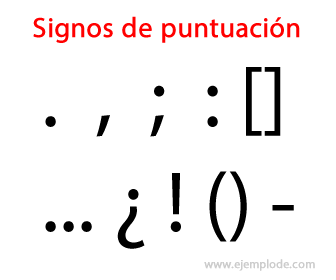Using Punctuation Marks
Spanish Classes / / July 04, 2021
The punctuation marks are spellings or orthographic signs that help us to score a text at different moments of the speech and improve their reading and comprehension. To give structure a text and indicate certain sense relationships between statements or sentences; They also serve us for highlight some part of the text, either a word or set of words, that have some special function or use. These orthographic signs are:
- Comma (,)
- Point (.)
- Semicolon (;)
- The two points (:)
- Suspensives points (…)
- The question marks (?)
- The exclamation marks (!)
- The quotation marks (" ")
- The brackets ([])
- The parentheses: ()
- The long dash or dash (-)
Punctuation marks are very important and indispensable; to know how they are used, we have to know the spelling rules of their writing.
Here is a list of examples of use of punctuation marks.
Use of punctuation marks

1. Use of the comma (,)
This punctuation mark virtually represents a short pause in speech. This pause can have different uses or meanings, such as the following:
- The comma is used for separate the containing elements to an enum: "They gave the children hard candies, chocolates, bonbons, lollipops, gum and much more"
- The comma is used for separate the word or words that work like vocative (vocative comma): "Son, come help me!"; "My friend, I would like to tell you something important"
- The comma is used for separate an explanatory sentence or phrase: “My brothers, older than me, used to always include me in their sports games and that's how I liked sports "
- The comma is used after interjections: “Oh, what a backache! ”; "Oh, how interesting what you tell me!"
- The comma is used to separate the conjunctions except except Y less from the main sentence (written before the conjunction): "They all came, except for Rogelio because he had a job ”; "I like all fruit, except apple"; "Most of us passed the course, except for two students"
- The comma is used for separate phrases and certain links from the rest of the sentence: "We will strive, yet we know that failure is possible"; “They are innocent and they were prosecuted; that is to say, an injustice was committed ".
- The comma is used for elide a verb that was already mentioned (elliptical comma): “Yesterday I had a salad with chicken; today, meat with vegetables and white rice ”.
2. Using the period (.)
This punctuation mark virtually represents a long pause in speech. Among the uses of the point we can highlight the following:
- The point is used when end of an abbreviation. For example: , lic., doc., mtro., mr., ms.
- The point and followed used to indicate the end of a sentence to separate it from another.
- The new paragraph used to indicate the term of the final sentence of a paragraph, which will be followed by another paragraph.
- The final point used to indicate the end of a text.
3. Use of semicolon (;)
This punctuation mark virtually represents a mean pause in speech. In general, this sign is used to establish meaningful relationships. Among the uses of the point we can highlight the following:
- The semicolon is used to separate two sentences with a sense relationship within a paragraph: "These animals only hunt at night; during the day they usually sleep ”.
- The semicolon is used to separate long enums, either made up of long sentences or even more enumerations: “Pedro, Angélica and Gustavo will be in charge of editing the images; Luis and Ramona, to edit the videos; Antonio, Paula and Roger, to investigate and place all the text and information ”.
- Semicolon used before certain phrases, such as adversarial, explanatory, concessive or consecutive: "The manuscript that the author submitted to various publishers was quite good; however, he received only negatives ”; “The following Monday is a national holiday; therefore, classes will be canceled ”; “There are quite a few problems between them; although, both have the idea of talking to fix things ”;
4. Using the colon (:)
The main function of this orthographic sign is to connect sentences or syntactic elements to establish certain relationships of meaning, in different ways. The uses of a colon include the following:
- The two points are used to connect two sentences that have a close semantic relationship, for example, cause-consequence, from Explanation, from conclusion, etc.: "The house has a black legend: murders took place here a decade ago ”; "The food was ready - we were all eager to try it."
- A colon is used after a search sentence enter a quote: The author affirms something very true: "capitalism is the evil of our time"
- A colon is used after a sentence that is used to enter an enum that explains said sentence. For example: "We buy all the drinks for the party: beers, prepared drinks, juices, mineral water, soft drinks... "
- The colon is used after a greeting or courtesy. For example: To whom it may concern:, Dear customers:, Dear executives:
5. Use of ellipsis (…)
This spelling sign is generally used to establish an interruption or pause in speech, with different purposes:
- The colon is used to pause for doubt, hesitation, or intrigue about what is being said. For example: “I didn't know what to do… I felt like everything was lost for me at that moment.”; "We got closer and we couldn't believe what we saw with our eyes ..."
- The colon is used to mark a suspension in some incomplete enumeration. For example: "There was everything: doctors, lawyers, veterinarians, philosophers, actors, musicians… ”; "Every day I eat a lot of fruit: apple, mango, pear, strawberry, melon, guava ..."
- The colon is used to omit something that is already known, for example, the end of a popular saying or saying. For example: "And as I told you yesterday… ”; "Shrimp that falls asleep ..."
- The colon is used to suggest some rude word: Son of the!!! Take me the!!! "It's a ..."
6. Use of question marks (?)
Question marks have only one function: are used to mark or express an interrogative meaning in sentences; therefore, these signs work to create interrogative sentences. After the final question mark, the next sentence must begin with a capital letter, unless a comma is placed first. Let's see examples:
- How did you manage to work things out with your partner? It seemed all over.
- What time was the doctor's appointment?
- Who is your favorite Hispanic American writer?
- Do you remember the conversation we had about it just a few weeks ago?
7. Use of exclamation marks (!)
The exclamation marks, as the name says, are used to indicate an expressive sense in sentences; with these signs admiring sentences are formed, sentences with which feelings or emotions are expressed. Let's see examples:
- What good food! My congratulations to whoever prepared it.
- I have no idea what you're talking about!
- You are so angry that you do not listen to reasons!
- Wait for me! I'm almost there!
- Hears!
- What a wonderful movie!
- How sad is this situation!
8. Use of quotation marks ("")
Among the uses of this spelling sign are the following:
- The colon is used to mark the beginning and end of a verbatim quote. For example: The first sentence of the novel Pedro Páramo by Juan Rulfo is: "I came to Comala because they told me that my father lived here, a certain Pedro Páramo."
- The colon is used to enclose the title of the chapter or part of a larger publication: I read the story "The night face up" by Julio Cortázar.
9. Using square brackets ([])
The brackets have a use similar to that of parentheses; in general, they serve to enclose some clarification or element What is it alien to speech. Among its particular uses are the following:
- Square brackets are used to introduce a clarification within which there will be some parentheses as well. For example: This text is by a well-known author [Alfonso Reyes (1889 - 1959)]
- When using the brackets with three ellipsis between the brackets […] I know marks that some part of the text of a verbatim quote has been omitted. For example: "The situation at that time becomes critical and extraordinary measures are required [...]"
10. Use of parentheses: ()
This spelling sign is used to enclose some clarification or limitation of some kind; it can have any of the following uses:
- Parentheses are used to enter clarifying data, such as dates or places, or to introduce clarifying phrases or sentences. For example: Diego Rivera (1886 - 1957) was a renowned Mexican muralist; Those who came with him (identical in bearing) also threatened to attack; Upon his death (last year), his property and his business became the property of his three sons.
- As with square brackets, they are used parentheses with three ellipsis (…) to indicate that some part of the text has been deleted within a quote: "The humor and comedy of this work lie in a sense of tragedy and absurdity [...]"
- In plays or movie scripts, parentheses are used to introduce annotations in the dialogues of the characters: ROBERTO (angry). I want everyone to get out of my sight and not come back to this house!
11. Using the long dash or dash (-)
The dash or long dash sign can have one of the following uses:
- The long dash or dash is used to mark the interventions of the dialoguesof the characters or the narrator in a narrative text: - What are you doing here? "I have something important to confess to you." Well... Speak quickly... Before I regret listening to you.
- The long dash or dash is used to introduce an explanatory sentence that can be omitted from the text; it is normally about comments of the authors on what they are saying. For example: In that year things were difficult — at least for me they were — but people insisted on pretending that nothing was happening.
It may interest you:
- Sentences with punctuation marks.



